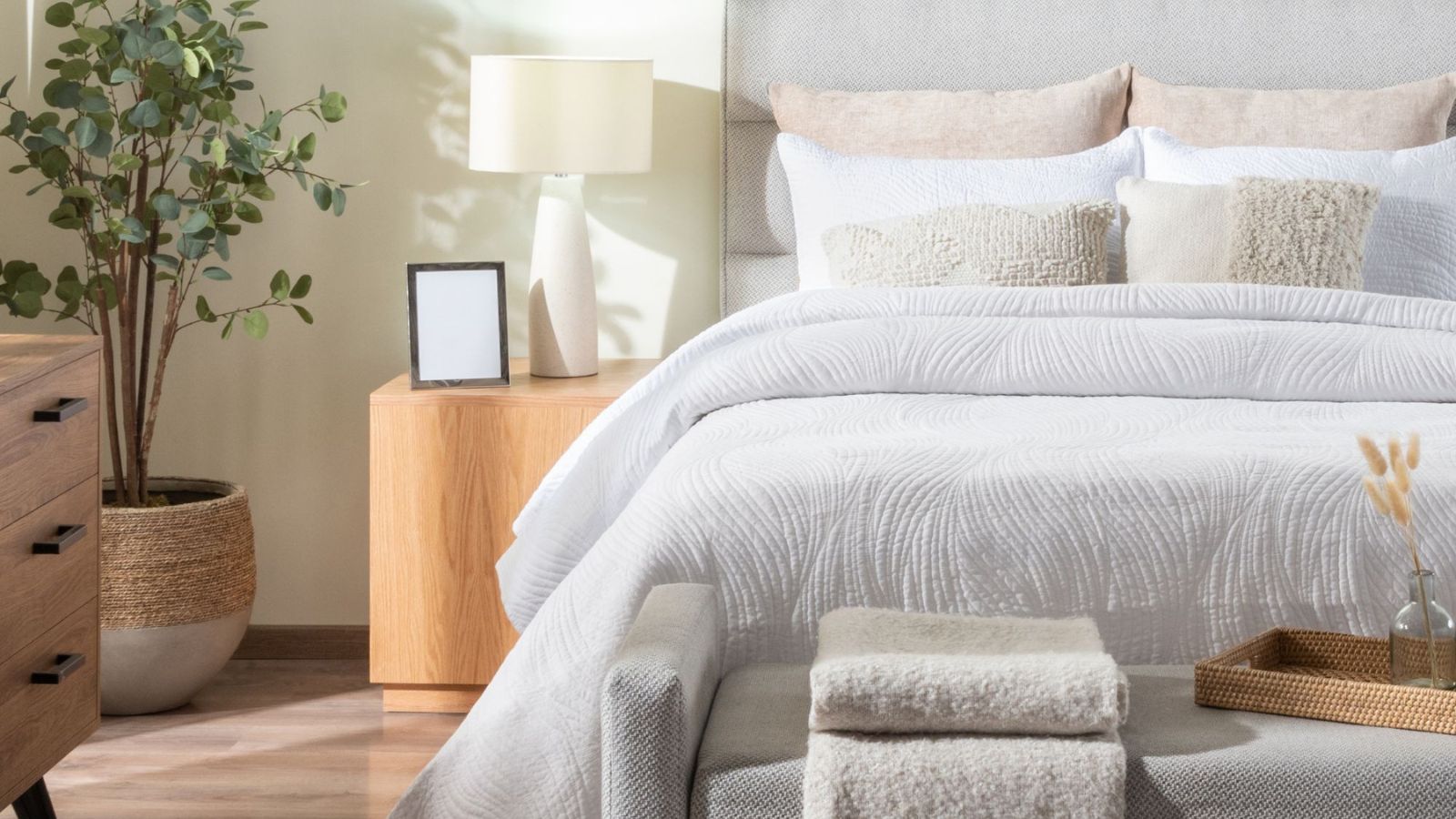
Given that we spend so much of our lives in bed, getting the bedding basics right should be a top priority. Avoiding common bedding mistakes can transform your bedroom into a sanctuary.
As the resident Sleep Editor here at Homes & Gardens, I lead a team of expert testers in the search to find the world's best bedding. Together, we've worked out which bedding mistakes to avoid to keep our beds looking their best. We want to share our hard-won wisdom with you.
I can tell you which bedding materials to avoid and which is the worst bed sheet color. I'll reveal the most common bedding laundry mistakes ruining the look and feel of your sheets and bust some bedding myths along the way.
Bedding mistakes − and how to avoid them
I asked an expert panel of product testers and bedding designers to identify the most common bedding mistakes and share their solutions. Whether you want to get a better night's sleep or upgrade the look of your bedroom, here's what you need to know.
1. Focusing too much on thread count
There is a common misconception that the higher the thread count, the better the sheets. In fact, the number of the threads is less significant than their thickness. Thicker fibers create stronger sheets, which are less likely to pill.
'Thread count is not regulated, and counts can be skewed in several different ways to make sheets sound better than they actually feel,' explains Amy Jourdan, merchandise buyer for Ballard Designs. 'You might see a sheet set advertised as 800TC, but it actually feels the same as a 400TC, because one retailer counts a 2-ply twisted yarn as double, and the other does not. I honestly suggest you make your decision after feeling the sheets by hand.'
The way the waft and weft threads are woven impacts how the linen looks and feels. That's why the best bed sheets vary from sleeper to sleeper.
I recommend these breathable bamboo sheets for hot sleepers and eco-conscious shoppers. Each flat sheet, fitted sheet, and pillowcase is made from bamboo lyocell, grown from 100% rainwater, and free from harmful chemicals and plastics.
These crisp, cool sheets are woven from 100% long-staple cotton into 270TC sheets. I've got dozens of sheet sets in my linen closet and these are the ones I turn to time and again, especially during hot nights and heat waves.
These Egyptian cotton sheets are woven from long, strong staples that resist pilling. Each sheet is available in a wide range of cool neutrals, from icy blue to charcoal gray, and double-hem stitched for a neat finish.
2. Choosing the wrong color for your space
There are no hard and fast rules about which colors are right or wrong for your bedroom. 'Which color is best all depends on the atmosphere you're trying to create,' says Georgia Metcalfe, founder of French Bedroom. 'I like to switch up the colors of my bedding throughout the year. For summer, I find that a set of the best white bed sheets will make a bedroom feel brighter.'
Some sleep scientists tell me that you should never use white bed sheets. According to Dorothy Chambers from SleepJunkie, bright whites are known to affect melatonin levels and keep you awake when you should be falling asleep. You might find that you feel more relaxed with off-white or beige bedding, instead.
'In the colder months, I would recommend warmer and richer colors for bedding,' continues Georgia. 'Shades of terracotta, deep green, navy blue, and coffee rank among the best bed sheet colors to improve sleep. Adding a throw and a couple of decorative cushions in similar tones should complete the comfy look.'
'I've spent the last year sleeping on Martha Stewart bedding,' says expert tester Camryn Rabideau. 'I didn't want to admit it, but I'm impressed. These sheets are hard-wearing yet seriously soft. I'm still sleeping on them more than a year later. I'd rank the Martha Stewart Down Comforter among the best duvet inserts.'
I built my own bedding bundle with Piglet in Bed so that I could create a bespoke bedspread. In the spirit of color drenching, I opted for all sage green, but you could mix and match between any number of colors.
If you're keen to experiment with prints and patterns, then Magic Linen is one of the best places to buy bedding. This Forest Green Gingham oozes retro charm.
3. Buying low-quality sheets
Between cotton, linen, bamboo, eucalyptus, microfiber and more, there are so many bed sheet types that it's easy to feel spoiled for choice. I understand the impulse to buy the cheapest sheets you can find, but I'd encourage you to take the materials into consideration. That's the only way to avoid buying low-quality sheets that don't suit your sleep style.
Before you start shopping, Amy recommends you 'think about which features you want from your bedding, whether that's temperature control (in which case, I suggest percale, bamboo, and linen) or a smooth finish (which you'll get from silk or sateen).'
'Apply the same sort of thinking to the rest of your bedding basics,' Amy continues. 'If you want a comforter with plenty of natural loft, you should opt for down over down alternative. If you sleep on your side, you need a thick, squashy pillow to support your neck and shoulders.'
These silky-smooth sateen sheets have sat at the top of our 'best bed sheets' buying guide for three years running. The Luxe Sateen Core Sheet Set boasts more than 17,000 five-star reviews on the Brooklinen site.
This down alternative duvet insert offers something for everyone. It's filled with recycled plastic for eco-conscious shoppers and wrapped in eucalyptus lyocell to cool hot sleepers. Tie it to your duvet cover or let it stand alone as a comforter.
I recommend this adjustable pillow to everybody: it's designed to suit all sleep positions. All you need to do is push and pull the zippers to let air into and out of the pillow until you reach your ideal thickness and feel.
4. Not bothering to style your bed
‘I’m a firm believer that you can never have too many cushions, throws, or bed linen,’ says Georgia. ‘Invest in a variety of soft furnishings and have fun playing with accessories in textures of cotton, velvet, and silk. A mix of materials brings layers of interest to neutral decors. If you’re a fan of bright colors, it’s a versatile and inexpensive way to show off your flair for the dramatic.’
Amy concurs: 'Layering is key! Shams and a duvet cover all in the same print or color can get old and boring quickly. I love to layer the bed with complimentary patterns and colors, usually on a base of white.'
'Bring in some varying texture too with a great coverlet or throw and/or throw pillow. The new extra long lumbar is a great option for the person that doesn’t like to load the bed with a lot of pillows. There are so many great options for styling the shams/pillows on the bed – look up sham styling online and find the option that’s right for you.' It's worth learning how to make a bed the right way before you begin.
5. Not washing your bedding correctly
Knowing how to wash bed sheets and how frequently you should be changing them might be mundane, but it’s important. Not washing bed linen properly is one of the most common bedding mistakes that could shorten the lifespan of even your most prized linen sets.
According to Chiana Dickson, our in-house cleaning expert who writes for our Solved column, 'you should wash your bedding once per week, more often if you have pets that share your bed or if you suffer from allergies.'
'Washing your bedding incorrectly, however, can degrade its quality. As a general rule, wash your bedding at 40 degrees on a gentle cycle to kill bacteria without ruining the look and feel of your sheets.'
6. Buying the wrong size of bedding
This might sound obvious, but you'd be surprised how often it happens: buying the wrong size of bedding means your sheets won't stay on the bed. Before you buy, I recommend cross-checking the dimensions of your bedding against our mattress size chart to make sure you've found a match.
Sheets are designed to fit a specific mattress depth: most commonly, somewhere between 10 and 15 inches. Some mattresses are thicker than this, especially if you've added a mattress topper, so you might need deep pocket sheets to ensure a snug fit. Bedding that is too tight or too loose could become cumbersome during the night as you naturally move around, waking you up with bunching.
Similarly, pillows need to fit the width of your bed correctly for the most comfortable sleep. Pillows that are too small for your bed could mean you won’t receive the full benefit of your bed's width, whereas pillows that are too large can overcrowd your bed. Measuring your pillows in comparison to your mattress can make all the difference.
7. Failing to store your bedding correctly
Learning how to correctly organize a linen closet can have surprising effects on the longevity of your bedding, according to experts. It is worth considering how you are going to store your bedding throughout the year when planning your bedroom storage ideas.
'Learning how to fold bedding is an invaluable skill to save space,' says Georgia. 'Bulky blankets and large towels can be hard to fold, whereas luxury duvets and pillows with goose down or feathers shouldn’t be squashed, as this will damage them. Roll these pieces, tie them with a ribbon, and store them vertically. They will be easier to access, and their quality will be preserved for longer.'
'One of our favorite hacks at French Bedroom is to store sets of sheets in their matching pillowcases,' Georgia continues. 'Fold your sheets neatly, then slide the set inside one of its pillowcases. Say goodbye to settling for cream sheets with white pillowcases and vice versa. Say hello to a perfectly styled bed every time.’
FAQs
Why do my bed sheets get little balls on them?
Those little balls on your bed sheets are a consequence of pilling, which happens when threads and fibers rub together, get tangled, and break. Pilling is most common in bedding with high threads counts and multi-ply yarns. Pilling happens through friction from nightly wear and tear or an abrasive cycle in the washing machine. If you want to learn how to stop bed sheets pilling, I suggest you read our expert explainer.
Why won't my sheets stay on the bed?
I've written an entire article answering the question, 'why aren't my sheets staying on the bed?' The answer: probably because your sheets aren't the right size for your mattress. Don't worry: you can pick up a set of Bed Sheet Holder Straps for a quick fix.







